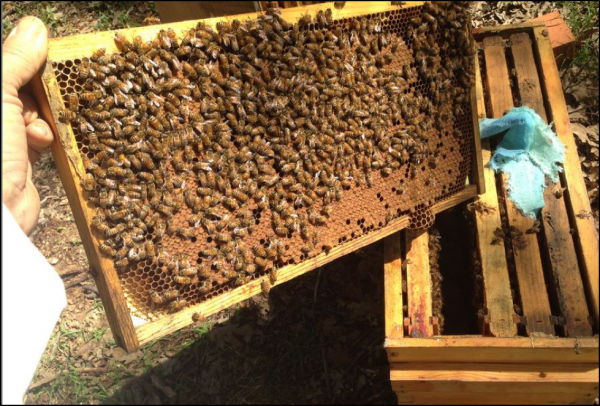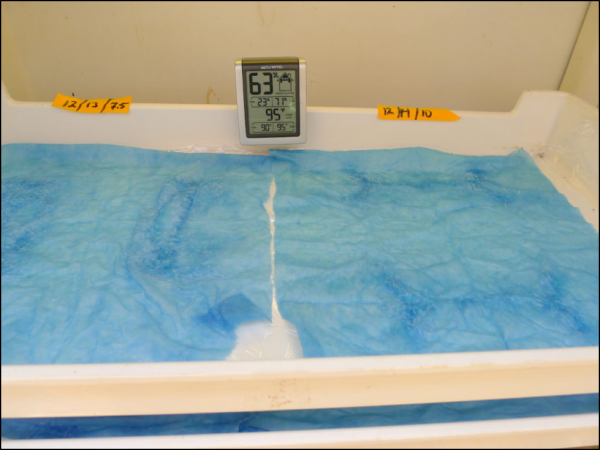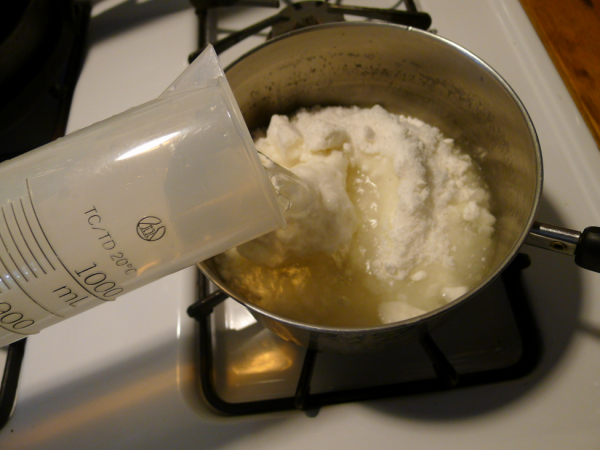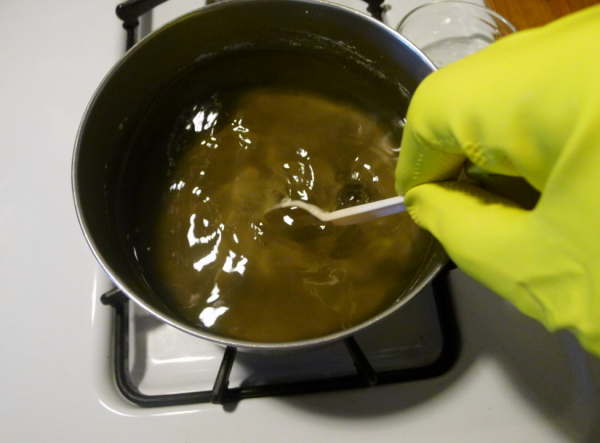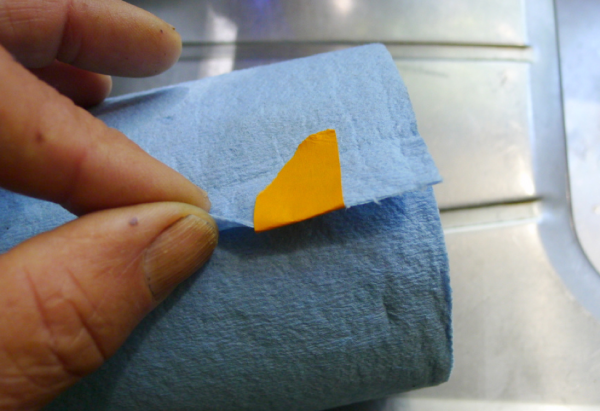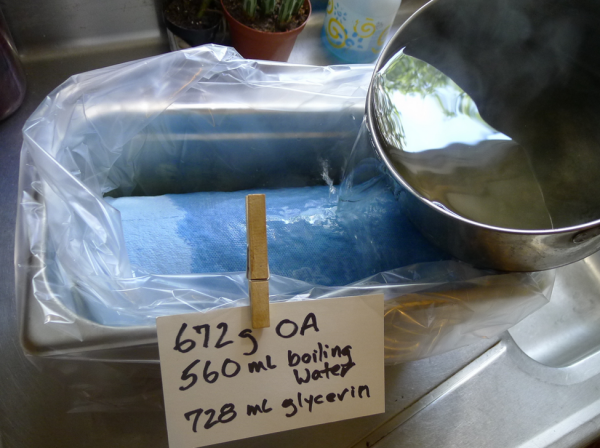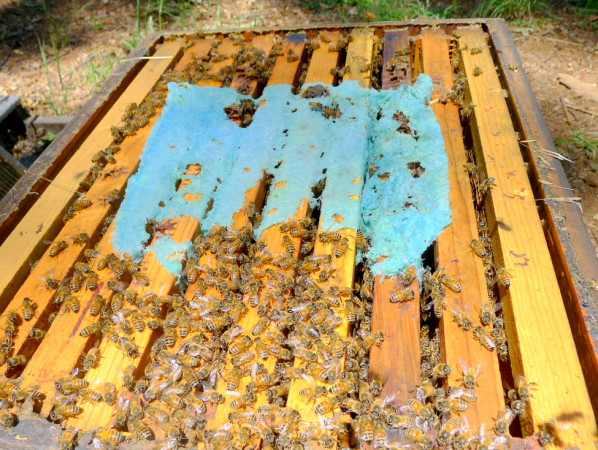Extended-Release Oxalic Acid Progress Report – Part 1
Extended-Release Oxalic Acid Progress Report
Part 1
Randy Oliver
ScientificBeekeeping.com
First published in ABJ July 2017
In January I wrote about an exciting extended-release application method for oxalic acid [[1]]. I’m currently collaborating with the USDA Agricultural Research Service and the EPA to get this application method added to the current label for oxalic acid. In the interest of full transparency (and to show how I’ve been putting your donations to use), I’m submitting this progress report.
Introduction
Beekeepers worldwide are caught between a mite that has proven able to rapidly develop resistance to synthetic miticides, and the slow pace of our development and adoption of mite-resistant bee stock (the eventual solution to varroa). During the interim, by choice or lack of alternatives, beekeepers are shifting to the use of “natural” treatments. Oxalic acid (OA) is one of the most promising of those treatments [[2]], but its efficacy is limited unless applied during a broodless period. An extended-application method would free it from that limitation.
Practical application: although the natural treatments can certainly be effective [[3]], let us not forget that we should still consider them as stopgap measures to be used while we move forward on breeding for mite-resistant bee stocks.
The problem with oxalic acid is that either of the currently approved application methods (dribble or vaporization) kills mites for only about three days. So unless applied during a broodless period, or repeated at 4-day intervals, oxalic is not very effective over much of the season (due to a proportion of the mites being protected in the sealed brood). By creating an extended-release formulation, we may have found a treatment that is “natural,” suitable for organic approval, safe for the applicator, non-contaminating of honey, showing no noticeable adverse effects upon the colony, as well as being inexpensive and highly efficacious at reducing mite populations (I saved the best two for last).
Practical application: oxalic clearly kills mites, but its mode of action is not yet clear. It may have the additional effect of messing with their olfaction or tactile sense. This is purely speculative, but keep in mind that even a small reduction in the mites’ reproductive success can turn it from being an adversary into a mere annoyance.
Preliminary research
Oxalic acid efficacy when dribbled is improved by the addition of humectants such as sugar or glycerin. The technicians of the National Institute of Agricultural Technology in Argentina developed an oxalic acid/glycerin (OA/gly) product using cardboard strips, applied for patent in 2014, and brought a product to market called Aluen CAP. Although similar OA/gly cardboard strips worked in my test hives, the strips were simply too tedious to insert and later remove.
Experimenting with other cellulose matrices, I found the commercial beekeeper standby–the blue shop towel–laid across the top bars between the brood chambers to fit the bill, since it didn’t need to be inserted between the frames, and the bees themselves would remove the spent treatment. The problem was, the bees avoided glycerin-saturated cellulose; it was only when I reduced the degree of glycerin saturation of the towels that the bees would chew the towels, thus exposing themselves to the oxalic acid, and distributing it throughout the colony as they carried the glycerin-rich cellulose strands down through the combs. This took the typical colony roughly a month and a half to do—perfect for effective treatment, with minimal treatment residue left afterward in the hive.
Practical application: OA/gly has the potential to be of huge benefit to our industry—we just need to get it legal to use. It is currently just as illegal to use oxalic towels in a hive as it is to use Taktic or other unapproved chemicals.
Surprisingly, the process by which oxalic acid was federally registered occurred largely behind the scenes. I’m writing this article in part to bring more transparency to this important process.
Registration for use
Our industry is crying for effective varroacides. EPA is well aware of the desperation of beekeepers due to the failure of the previously-registered miticides (state lead agencies have been applying for an unprecedented number of Section 18 emergency registrations), and has been forced to turn a blind eye to our industry’s “off label” use of unapproved chemicals (including Taktic and oxalic acid).
Back in 2006, Dr. Marion Ellis and his student Nick Aliano confirmed European studies as to oxalic acid’s effectiveness as a varroacide [[4]], yet despite his best efforts, it took years to get it registered for use in the U.S.
The EPA is not responsible for bringing products to market—that’s up to the registrant. And the EPA doesn’t do the testing involved for registration–potential registrants need to submit the supportive data (generally generated by independent testing labs) to support the safety and efficacy of a product that they wish to register for sale, and to pay for such testing and subsequent review by the Agency. This process can be quite costly.
The problem with oxalic acid registration was that there was no incentive for a private chemical company to invest the substantial sum required to get it registered for sale to beekeepers—since it couldn’t be patented and was already readily and cheaply available at any hardware store, there would be little expected return on the investment.
As it became more and more evident that oxalic acid was an effective and safe mite treatment already registered for use in a number of other countries, pressure built for it to be “made legal” in the U.S. Then in 2014 President Obama highlighted specific instructions for EPA to review registration applications for new products targeting pests harmful to pollinators. Our Agricultural Research Service (ARS) stepped up to the plate and applied as the registrant for oxalic acid, and under an inter-agency cooperation agreement with EPA, was able to reduce the cost of registration.
EPA then expedited the registration process. This was done via a “work share” agreement with Canada’s Pest Management Regulatory Agency, which provided the necessary data reviews (Canada had registered oxalic in 2010). EPA issued a registration decision in spring of 2015 [[5]]. A distributor was sought for ARS to license for sale of oxalic acid as a varroa treatment; Brushy Mountain Bee Farm volunteered to play the role (not surprisingly, the amount of “approved” OA that they actually sell suggests that many beekeepers are using off-the-shelf unapproved oxalic acid).
Practical application: The current label allows only for trickle, vaporizer, or spray applications, and states, “Use only in late fall or early spring when little or no brood is present” and “Do not use when honey supers are in place to prevent contamination of marketable honey.” These last two restrictions prevent us from using oxalic acid for mite control when we most need it—in late summer before we’ve pulled the last of our honey, when mite counts are exploding.
So I approached EPA and ARS to see whether we could get the extended-release OA/gly application method approved. This would likely have been relatively easy, but I also said that we needed to get it approved for use when honey supers were on. This complicated things, since now we needed to deal with whether there would be residues in the honey, despite the fact that there is abundant data from Europe and Argentina that residues wouldn’t be expected; EPA needs to go by the book.
Although the EPA representatives in Risk Assessment and Registration, as well as ARS, have been extremely helpful, they’ve made it clear that they cannot shortcut the registration process, and must treat us like any other private registrant. Jay Evans, Research Leader of the USDA-ARS Bee Research Lab in Beltsville (who wasn’t involved in the original registration process) and I are on a learning curve for how to get a miticide through the registration process—unlike the chemical companies, we don’t have an established staff familiar with the process of the details involved in pesticide registration [[6]].
Our situation: the shop towel application method has to date been only cursorily tested—with scant hard supportive data. So we’re trying to kill several birds with one stone in our trials:
- To determine the efficacy of different doses of OA/gly at reducing mite populations,
- To look for adverse effects on the colony due to treatment, and
- To measuring whether treatment increases the amount of OA that naturally occurs in honey.
As you might imagine, we’ve gone through draft after draft of experimental protocols, and at this writing, are about to begin the first trials.
We are currently planning to run concurrent trials in low-humidity California (me) and high-humidity Georgia (with collaborators Jennifer Berry from University of Georgia and Geoffrey Williams from Auburn University), at three different doses of OA, with solvent (glycerin-only towels) and sham (dry paper towels) control groups. I have received a Pesticide Research Authorization from California Department of Pesticide Registration to perform such testing.
Practical experience: it is indeed interesting to be required to jump through the same EPA hoops as do the pesticide companies when they register a new product. And although it seems to me that the OA/gly application method should be a slam-dunk, EPA has made it clear that despite guidance to expedite the registration of safe varroa-control products, that they aren’t about to shortcut their requirements for good supportive data. I thank the EPA personnel with whom I’m communicating for being helpful, and greatly respect them for their diligence at doing their job properly.
Distributors
The status of oxalic acid is that the only entity currently authorized to sell it as a varroa control product is Brushy Mountain Bee Farm. The small quantities offered by Brushy won’t fill the needs of commercial operators (although they will special order 55-lb bags for those who request them). If demand grows (should this application method be approved), Brushy or other distributors will make “legal” bulk oxalic available.
Chemical terminology: Although anhydrous oxalic acid is available as a chemical reagent, with regard to this article, every mention of oxalic acid refers to common oxalic acid dihydrate (the acid bonded to two water molecules) commercially sold as a cleaning and bleaching agent.
The preparation of OA/gly towels requires some mixing and pouring of a heated acidic solution—something that the EPA risk assessors aren’t crazy about. But since the towels are so inexpensive to make (they cost me about 25¢ ea to prepare), I’m hoping that a manufacturer will follow up and offer a preformulated product to the market at a reasonable cost.
OA/Gly is still not an approved use
At this point I want to make perfectly clear that this article is an informational progress report only, in the interest providing full transparency of my approved experimentation and involvement in the registration process.
Disclaimer and legality: I do not encourage nor condone the illegal application of any pesticide, including mite treatments to bee hives. The information in this article is solely to report on my progress (working in conjunction with ARS) towards getting this application method approved by EPA, and is not intended to promote illegal use in any way. I neither approve of, nor encourage, applications not sanctioned by local authorities [[7]]. If you wish to experiment yourself, please check with your State Lead Agency for pesticide regulation to see whether you need to obtain an experimental use permit [[8]].
Progress on the application method
There has been considerable interest worldwide on OA/gly application, and my shop towel article has already been translated and reprinted in other countries [[9]]. Since publication, I’ve done quite a bit of further experimentation, and have received field feedback from other beekeepers (whom I presume have obtained use permits for experimentation). You can follow our progress at https://scientificbeekeeping.com/oxalic-shop-towel-updates/
Adverse Effects: although I received a couple of reports from beekeepers that OA/gly applications appeared to harm their test hives, neither I nor several large-scale beekeepers have noticed any such adverse effects. One sent me data from 50 hives treated in spring with shop towels compared to 50 treated with Apivar strips—after 46 days there was no statistical difference between buildup or increase in number of frames of brood between the two. I’ve applied towels to colonies midwinter during rain and snow, and to nucs building up in the spring (Fig. 1), and have yet to see a problem.
Figure 1. A frame from a nuc this spring, halfway through treatment, with a half-chewed OA/gly towel pulled to the side. Note the solid brood pattern. To my surprise, these “acidified” hives do not appear to exhibit noticeable adverse effects so far as buildup, brood development, or queen problems.
Dosage and efficacy: Although I obtained good efficacy in late summer with a single towel treatment per double deep hive, I wasn’t impressed by the degree of mite knockback from spring treatment. The amount of OA is limited to 12 g per towel (more further on), so I’m experimenting with stacking two or three towels one atop the other to increase the OA dose per hive.
I have yet to determine the optimal dosage rates for growing colonies in the springtime, for treatment during the honey flow, or for late summer treatment in dry or humid climates. We hope to answer these questions with further testing, and from beekeeper feedback. Luckily, there appears to be room to increase the dose– neither Maggi [[10]], nor I in my trial last summer, observed any adverse effects from applying up to 80 g of OA per hive in cardboard strips—the equivalent to that in a total of 7 shop towels.
Duration of treatment: A typical varroa reproductive cycle takes around 17 days, so a 35-45-day exposure would cover two generations. It’s not yet clear whether a 35-day exposure is optimal, or whether it needs to be for a longer duration. However, since the presence of the towel hampers hive inspection, I’d prefer to increase the dose if necessary, rather than prolonging how long there needs to be a towel in the hive.
The cellulose substrate and saturation: In the first place, I’m not hung up on shop towels—other biodegradable cellulose substrates could serve just as well. What we want is a substrate that is fibrous, so that the bees wind up distributing the OA/gly throughout the hive during the process of removal, and that also stimulates the bees to perform such removal. Beekeepers already know that blue shop towels meet those criteria.
With shop towels, the key issue appears to be the degree of saturation of the towel with glycerin—too “wet” and the bees simply avoid it. But at about 50% saturation, the bees chew and remove the towel with vigor, effecting near complete removal in little over a month. The trick is to get the towels to evenly wick to half saturation, so that the applied dosage in each towel is consistent.
Initially, I pressed half the liquid back out of the towels after they were saturated. But this was a pain, and it was difficult to get the towels to evenly absorb the solution. So I looked for another way to prepare half-saturated towels…
Chemistry, solubility, and saturated solutions: for the registration process, I needed to come up with an exact formulation to test. That involved a goodly amount of kitchen chemistry experimentation—making batch after batch of solutions and towels in order to arrive at an appropriate formulated product that we could test in controlled field trials.
Here are some of the considerations:
- The main limiting factor is the maximum amount of glycerin that can be added to each towel and still result in good chewing and removal by the bees—this appears to be about 13 mL.
- Then there is the matter of the maximum amount of OA dihydrate that can remain in solution in that 13 mL of glycerin at broodnest temperature—this appears to be about 12 g. At this degree of saturation, some oxalic acid will precipitate out (recrystallize) at room temperature–which actually makes the towels a bit easier to handle and apply (they become “stiffer” and less messy).
- Glycerin is hygroscopic and will absorb moisture (water) from the air at high humidity. I used my queen cell incubator (Fig. 2), which is held at broodnest temperature and humidity, to test how prepared towels would react to those conditions—the towels rehydrate and the oxalic crystals redissolve.
- Anhydrous laboratory OA will react with glycerin to form oxalate esters, especially at high temperatures. Less clear is to what degree the commonly sold OA dihydrate (wood bleach) will do so, or whether the presence of added water inhibits or reverses such esterification [[11]]. Bottom line—low heat and added water are likely good.
- The viscous glycerin solution does not wick well through a roll of towels. A hot solution wicks better. But a cold roll of towels may cause the OA to crystallize out before even saturation of the roll is obtained. Adding water to the solution greatly improves wicking.
- Oxalic acid is relatively insoluble in room-temperature water (13.3 g/100 mL at 68°F), but highly soluble in hot water (168 g/100 mL at 194°F).
- Besides rolled towels, I experimented with interfolded or hand-stacked towels. The rolled towels were the easiest to dispense in the field, as the interfolded or stacked towels were difficult to peel apart.
Figure 2. Testing formulations at broodnest temperature and humidity in my queen cell incubator. An air-dried towel which feels “dry” at room temperature and low humidity, quickly rehydrates and softens under broodnest conditions of 95°F and 65% RH.
OK, after a lot of experimentation, I’ve arrived at a working formula (as of this writing) that is easy and safe to prepare, that wicks quickly and uniformly into a roll of towels, and produces a towel with the right attributes for handling in the field and dispensing of the treatment within the hive:
| My working formula for OA/gly towels | Per towel* | Per roll of 55 towels** | Per half roll*** |
| Oxalic acid dihydrate (99.6% purity) | 12 g | 672 g | 336 g |
| Water | 10 mL | 560 mL | 280 mL |
| Vegetable glycerin (food grade) | 13 mL | 728 mL | 364 mL |
| *For a Scott Shop Towel—I haven’t experimented with other towels that may differ in absorption.
**The per-towel formula x 56 to account for the amount of solution absorbed by the center cardboard roll. ***Cut in half crosswise with a kitchen knife.
|
|||
My preparation of towels for experimentation
THIS IS A PROGRESS REPORT ONLY OF MY LEGAL EXPERIMENTATION; THIS APPLICATION METHOD HAS NOT YET BEEN REGISTERED WITH THE EPA.
Safety
Oxalic acid is commonly used for bleaching decks and cleaning metal, and has a long history of being safely used, with standard precautions. However, it’s easy to forget that you’re still working with a strong acid. Although oxalic acid is not nearly as corrosive as battery acid, it’s still an acid, and any stray drops of the solution remain caustic indefinitely. And in the processes of weighing and mixing, tiny crystals of acid and droplets of solution invariably spill onto work surfaces.
I make a point of wearing safety glasses (in case of splashes) and nitrile or kitchen gloves (the label calls for the wearing of 14 mil gloves). Wearing gloves reminds me not to touch anything, and to clean up any tiny splashes or spills.
Since the OA/gly solution doesn’t cause any sort of immediate burning sensation if it gets on the skin (unless it enters a cut), it’s easy not to notice if I’ve gotten acid on my fingers, and even worse, the glycerin makes the solution stick to absolutely everything. I find that this makes it especially important for me to be conscientious, meticulous, and fastidious, since I sure don’t want to accidentally rub my eye, or get the corrosive solution onto my cell phone or computer, or (heaven forbid) touch my wife’s…er…face with acidified fingertips. Luckily, the solution is easily washed off with warm water, and a solution of baking soda in water neutralizes any residual acid on work surfaces.
I wash my gloves before I pull them off, and then wash my hands. I’ve gotten into the habit of tasting my fingers after I’ve washed them, to double check that I’ve gotten off all the acid, since one’s taste buds are exquisitely sensitive to acids, and even a trace of oxalic acid makes your fingers taste like tart rhubarb pie.
Practical application: Although oxalic acid is a common component of vegetables, and can be considered as being “food grade,” it is nevertheless a strong acid, and in the concentrated form used in OA/gly towels, it packs a lot of acid wallop into every tiny drop. I find that I need to continually remind myself to exercise basic lab safety precautions to protect my skin, and to make sure that I pay attention to the thin film of solution that sticks to my gloves, and to not touch anything else after I’ve touched a prepared towel.
I prepare the solutions in my kitchen (a dedicated work area with a sink would be better), after warning my wife to stay clear. I keep a spoon rest next to the pot, so that I have a dedicated place to set the spoon between stirrings. I do any pouring in the sink, or over a catch tray, and have running water handy so that I can immediately wash off any spills, especially should I get it into my eyes. That said, I find that with the above precautions, preparing OA/gly shop towels can easily be done quickly and safely.
Measuring devices
I use a triple-beam balance to weigh the acid crystals, using a 32-oz plastic yogurt container (after checking the tare weight), which holds enough oxalic to make one batch of towels. I use a 1000 mL plastic graduated cylinder to measure the water and glycerin.
Preparation
I’ve been mixing the solutions in a dedicated stainless steel saucepan (which immediately discolored). I found that it was safest to first place the acid crystals into the pan before adding any liquid, since this greatly reduces the chance of splashing. I then gently pour in hot water (Fig. 3).
Figure 3. In order to minimize the chance of splashes, I first place the oxalic acid crystals into a dedicated stainless steel saucepan, and then gently pour in the measured amount of hot water. It then requires some further heating to fully dissolve the OA in the water.
I then turn on the burner, and gently stir the solution as it heats. I found that the lumps of oxalic acid crystals break apart and dissolve far more easily in hot water than in hot glycerin [[12]]. I continue stirring until the crystals are fully dissolved, and the solution is crystal clear (Fig. 4).
Figure 4. I stir until the solution is crystal clear (the brown color is discoloration of the pan itself, not the solution). I don’t heat to anywhere near boiling. Note the glass spoon rest bowl in which to place the spoon between stirrings (I use a plastic spoon). At this point, I turn off the heat.
I then carefully move the pan to the sink or pouring tray, and gently pour in the measured amount of glycerin, then mix thoroughly, so that each towel will end up with the same amount of active ingredient. Then I prepare a roll of shop towels (Fig. 5).
Figure 5. To save time later fumbling in the field, I lift the corner of the first towel and mark it with tape, since it is tricky to locate the free edge once the towels have been soaked. To date, I’ve experimented only with Scott brand Shop Towels.
If I’m preparing only a few towels, I simply fold them and place them into a large Ziploc bag, into which I can pour the appropriate amount of solution. I place the bag into a bowl, with the edges folded back for easy pouring. For a full roll, I found that a 1/3 x 6” stainless steel steam table insert pan (from any restaurant supply) holds a full roll of shop towels very nicely. I first line the insert pan with a transparent (so that I can watch the absorption process) plastic turkey roasting bag, again folding it back to provide a clear opening.
At this point, I generally pour the still-hot solution over the roll of towels (Fig. 6).
Figure 6. I’m pouring hot OA/glycerin solution evenly over a test roll of towels. After pouring, I lift the bag of towels out of the pan and rotate the towel roll in the bag to allow absorption into any dry areas. Full absorption occurs within about 2 minutes. .
After the solution is fully absorbed, I stroke any wrinkles out of the roll of wet towels (to make for easier unrolling of the towels in the field). I then open the bag (or remove the roll and place it into a plastic tray) in order to allow the excess water to evaporate. This makes the towels less slippery when we later apply them in the field.
Avoiding a hot pour: I also tested to see whether a roll will absorb a cooler solution. The problem to overcome is that as a cooler solution wicks into the roll, the cold layers of towels cool the solution, causing the OA to crystallize out of solution before it reaches the center, thus resulting in uneven distribution.
In this experiment, I allowed the solution to cool ‘til it was warm to the touch (110°F). Then I prewarmed the roll of towels for 30 seconds in a microwave in order to prevent crystallization during absorption.
Caution: microwave heating for over 30 seconds may cause the towels to overheat and start to smell like they are about to catch fire!
Result: The solution wicked into the prewarmed roll very nicely (but more slowly).
Practical application: other than saving time, there is apparently no need to heat the solution, nor the roll of towels, above 110°F at any time during the process of preparation (so long as you’d added the glycerin along with the water). But I haven’t yet had the patience to try this [[13]].
Shelf life
I have some rolls of towels that I made months ago and stored at room temperature, that still peel easily and look (and taste) essentially the same as the day that I made them. That said, I suggest that towels be prepared shortly before use in order to avoid recrystallization of OA at the edges.
Field application
I find the towels difficult to apply by myself, since I don’t want to get the sticky acidic solution on my smoker or hive tool—so I work with a helper. We carry the towels to the field in a plastic bag, and choose one of us to be the designated Towel Applicator [[14]]—he/she wears 14 mil gloves and is the only one who ever touches a towel. The other crew member tips open the hives and smokes the bees. The Towel Applicator carries the roll of formulated towels, and peels individual towels from the roll to apply to the hives (Fig. 7).
Figure 7. Note how if the excess water is allowed to evaporate off, the towels get a bit stiff and easy to handle. With a 2-person crew, it’s a simple matter to tear them off one at a time and apply them to the hives.
We make a point to carry wash water and plastic disposal bags to the yards, and don’t allow the Towel Applicator to touch anything other than the towels themselves. After application, any remaining towels are safely secured, and then the Towel Applicator can wash and remove the gloves.
Practical experience: the towels look so benign, that I must regularly point out to helpers that they can’t touch a towel and then touch something else, without first rinsing their fingers. It would be very easy for the careless helper to acidify their hive tool, smoker, the steering wheel of our truck, or whatever else they next touched! Always keep wash water on hand (a labeled jug of water and baking soda for neutralization is handy).
I’m currently testing by laying a full towel (or stacked towels) over the top bars between two brood chambers, centered over the cluster.
- There may be benefit to using two half towels instead, placed crossways across the frames with a slight space between them, so that the bees have a passageway up and down, but I haven’t yet formally tested.
- The towels do not work well if placed at the top of the hive directly under the cover—the bees don’t tend to chew them unless they have access from both top and bottom. Using a spacer rim (to allow bees top access to the towels) appears to help when applying to singles.
With a single layer of towel, the chewing by the bees is noticeable within a few days (as are fallen mites on top of the towels) (Fig.8).
Figure 8. A typical towel after about 20 days in a moderately-strong hive. Nearly all of the towel will be completely gone in 30-45 days. We see blue towel fibers on the ground in front of the hives, where they will harmlessly biodegrade after the next rain.
A caution: when I need to pull frames from below a towel during treatment, I flip the towel aside with my hive tool. I make a point to not forget that any towel residue is still corrosive, and that I need to rinse my hive tool immediately afterward. It would be better yet to keep a dedicated set of kitchen tongs handy.
Development of resistant mites
I’m often asked the question; won’t varroa develop some degree of resistance to oxalic acid? The biological answer is that one would certainly expect so if oxalic acid were applied over many generations without rotation of treatments. But that does not appear to be the case. In a recent study, Dr. Matías Maggi [[15]] compared the susceptibility to oxalic acid between two Argentinian mite populations:
- One that had been exposed to 64 consecutive treatments of oxalic acid dribble (8 times a year for 8 years) as the sole mite treatment, vs.
- A control population that had never been exposed to beekeeper-applied organic acids (the beekeeper had used coumaphos, flumethrin, or amitraz in a rotation scheme).
He found that the oxalic-exposed mite population didn’t exhibit any sign of resistance—in fact, it surprisingly appeared to actually be more susceptible to oxalic than the oxalic-naïve population. This is good news, since it suggests that whatever the mode of action of oxalic acid is against mites, that it’s not easy for them to develop resistance.
Update 20 May 2017
Research Update on the Oxalic/glycerin application method
We now have two formal field trials underway for registration of OA/glycerin towels as an approved application method. What I want everyone to keep in mind is that this research is in the very preliminary stages. I’m getting (and hearing of) mixed results on efficacy during spring buildup, and clearly see that efficacy is largely dependent upon the removal rate of the towels—unless the bees chew and remove the towels, there is little reduction in the mite population.
I’m also finding that we could use some consistency in terminology, so I’ll use that from a patent application filed in 2005 by Stuart Volby [[16]] for a degradable miticide strip. Stuart used the terms “active ingredient,” “carrier,” and “matrix.” In the case of the oxalic shop towel, the applied formulated towel is the delivery vehicle, with oxalic acid being the active ingredient, glycerin the carrier, and the cellulose shop towel the matrix. The active ingredient is distributed throughout the hive by the action of the bees rubbing against and removing the matrix. Ideally, the entire delivery vehicle is entirely removed from the hive by the bees by the end of the treatment period (thus eliminating the problem with plastic miticide strips, which continue to release active ingredient if not physically removed from the hive by the beekeeper, thus facilitating the evolution of miticide-resistant mites).
I chose the shop towel for my initial trial due to its familiarity to commercial beekeepers, as well as for its absorptive, fibrous, and biodegradable nature. But shop towels may well not be the ideal delivery vehicle—the most oxalic acid that I can get into solution in the amount of glycerin that is not repellent to bees is about 12 grams. In my test hives, when I stacked towels to increase the total dosage, the bees did not chew the towels adequately. So since my last article I’ve changed the protocol, and am formally testing the application of three half-towel strips.
I plan to experiment with other matrices, especially those that can hold more oxalic acid.
Update 29 June 2017
We just finished our midpoint grading of the Calif early-season trial. A heat wave quashed our honey flow, so the colonies did not build up and remove the towels very well in some of the test hives. That said, at 3 weeks into the trial, mite suppression was erratic. I haven’t yet worked the data, but it appears that the towel application method may not be adequate for mite control early in the season.
Acknowledgements
Thank you to all the beekeepers who have donated to ScientificBeekeeping, which allows me to fund this research—thanks for your support! I’d also like to express my appreciation to Dr. Matías Maggi and his dedicated group of collaborators in Argentina for their groundbreaking research. And to retired chemist and beekeeper Dick Cryberg for his help with the chemistry, and those beekeepers who have shared their experimental results with me. And of course to Jay Evans and David Epstein of the USDA ARS, and to the EPA personnel working with us to register this application method for the benefit of U.S. beekeepers.
Notes and Citations
[1] Oliver, R (2017) Beyond Taktic®. ABJ 157(1): 43-50. https://scientificbeekeeping.com/beyond-taktic/
[2] I’ve successfully used it in my commercial operation for over ten years.
[3] I haven’t found need to any synthetic miticides for going on 17 years now.
[4] Aliano, NP, MD Ellis, BD Siegfried (2006) Acute contact toxicity of oxalic acid to Varroa destructor (Acari: Varroidae) and their Apis mellifera (Hymenoptera: Apidae) hosts in laboratory bioassays. J. Econ. Entomol. 99(5): 1579-1582
Aliano, Nicholas P. and Ellis, Marion D. (2009) Oxalic acid: A prospective tool for reducing Varroa mite populations in package bees. Experimental and Applied Acarology 48: 303–309.
[5] https://www.regulations.gov/document?D=EPA-HQ-OPP-2015-0043-0119
[6] Something that I find interesting: EPA calls for data, but leaves it to the registrant to design the experiments. Only after the data is submitted, does EPA decide whether the experiments were properly designed.
A frustrating thing is that our current Administration, apparently in a politically-motivated effort to suppress the public’s access to taxpayer-funded scientific information, has across the board blocked online access to previously accessible supportive documents, including those for EPA’s registration of oxalic acid.
[7] I’m not completely clear as to the legality of individuals using oxalic acid dissolved in glycerin for their own use (not for sale to others). I’m also not clear to what degree the label restricts the allowed timing of treatments, since the label states both, “Use only in late fall or early spring when little or no brood is present, as well as “This product can also be used as a “clean up” Varroa treatment following the application of a different acaricide where Varroa infestations continue to be problematic.”
Not only that, but FIFRA Section 2(ee) (3) allows an exemption for “employing any method of application not prohibited by the labeling unless the labeling specifically states that the product may be applied only by the methods specified on the labeling.” After speaking with an EPA representative, I found that this would likely apply if the OA were purchased from Brushy mountain, with the caveat that application would still be restricted to use only when honey for intended for harvest was not on the hive.
The EPA is concerned that off-the-shelf oxalic might contain contaminants that might get into honey. Oddly, the label for OA as a mite treatment lists it as being only 97% pure—but on Amazon, you can purchase virtually pure (99.6+%) oxalic acid cheaply (I’ve been happy with Wintersun’s 55-lb bags).
Oddly, it is perfectly legal to use oxalic wood bleach to whiten the top bars of your frames, so long as your intent isn’t to use it as a miticide. Although disingenuous, I’ve heard that some beekeepers claim to use it for that very purpose, saying that whitened top bars look so pretty.
The reality is that each state’s Lead Agency has limited funds for enforcement, and may be reasonable. You may wish to speak with your local pesticide enforcement office.
[8] Please do not bother your EPA district office—the EPA Registration department would prefer to handle the process without needless confusion.
[9] U.S. beekeepers may not be aware that there are a lot of very smart beekeepers elsewhere in the world, and some great beekeeping magazines—if you can figure out how to translate them.
[10] Maggi, M, et al (2015) A new formulation of oxalic acid for Varroa destructor control applied in Apis mellifera colonies in the presence of brood. Apidologie 47(4): 596–605.
[11] I’ve read every bit of chemistry that I can find on the subject, and have discussed this at length with retired chemist Dick Cryberg. It is easy to observe that some sort of chemical reaction taking place between OA dihydrate and glycerin once the temperature reaches 160°F (since bubbles are produced). I’d appreciate the help of any chemist who’d like to do lab analysis on this.
[12] There is likely the added benefit that the water shifts the chemical equilibrium against the formation of oxalate esters that occurs if the acid is first dissolved in hot glycerin.
[13] Other experimenters—please let me know if you try this.
[14] We don’t yet have a special hat for the designated Towel Applicator, but we’re working on it.
[15] Maggi, MD, et al (2017) The susceptibility of Varroa destructor against oxalic acid: a study case. Bulletin of Insectology 70 (1): (preprint).
[16] https://www.google.com/patents/US20070059333. Disclosure: I tested some strip formulations for Stuart.




